
On the Road to Somewhere
Measuring Access to Opportunities is the future math of mobility
Eric Lind, Director, CTS Accessibility Observatory

In December 2022, Twin Cities policymakers and planners celebrated the opening of the D Line, the latest bus rapid transit project by Metro Transit. The new line strengthened the spine of service running north-south through the urbanized core of the region: from Brooklyn Center, following Minneapolis’ long axis to the south, through the gridded suburbs of Richfield and Bloomington all the way to the Mall of America. Largely replacing Minnesota’s single busiest bus route (Route 5), the D Line features expanded high-frequency hours, higher-capacity vehicles, and improved trip speeds. The D Line represents the best of local transit service, an undoubtable improvement for the mobility of transit riders.
Then in the spring of 2023 came less celebrated news in the neighborhood. In North Minneapolis, the Aldi grocery store announced it was closing permanently; soon after, the Walmart just steps from the D Line’s north terminal announced the same. The brightly painted articulated D Line buses still carried record numbers of riders quickly up and down the corridor—but for residents counting on the bus to get them to their shopping errands, the D Line was now just a little less useful.
The future math of mobility is to measure accessibility. The data and tools are ready, and it is up to researchers, advocates, and implementing agencies to begin working together to use these metrics for decision making.
This example emphasizes an old and maybe obvious idea about urban systems: transportation is about moving someplace and most trips are about getting to something that isn’t right at hand. The journey can certainly be half the fun, and moving without a true destination in mind is a valuable kind of freedom. But everyday trips begin with a pin stuck into a mental or digital map, with the paths between here and there the cost you have to pay to reach the opportunity at the end of the trip. Transportation planners almost always evaluate projects and networks according to that cost of movement, measured in time. Travelers, and the map apps we increasingly rely on, do the same with our daily errands. Even as a trip is underway, the app is searching—perhaps a faster route is available?

Thinking about trips individually like this, or focusing on the worst (slowest) trips we take, leads to an emphasis on delay, on traffic congestion, on the obstacles external to the windshield preventing us from making good time (these are most often other people). In fact, transportation engineering and evaluation of its success is completely dominated by these types of metrics: hours wasted in traffic, vehicle delay, school grade-like levels of service. The overriding idea is that throughput of vehicles should be maximized—everywhere—so that everyone can always see their trips lighting up green on map apps. Making it faster to go places is one way to lower your cost of travel. That is transportation oriented to mobility, the absence of delay.
But pure mobility has a very high cost. Safety trades off with speed; one or two minutes of predictable savings in drive time can be predictably more deadly when crashes occur. This is especially true when vehicles travel through places with a mix of people walking, biking, or just being outside of a vehicle. Highways that are expanded in response to congestion simply promote more use of the temporarily “cheaper” roadway. Ultimately, though, expansions return to the congested state within a few years, with a result of increased vehicle miles traveled in the meantime. Roads themselves, as transportation infrastructure, take up space intrusively and exclusively throughout otherwise people-oriented landscapes. There is a long history of strongly negative societal impacts of these mobility choices—to say nothing of the most sacrosanct component of a high-mobility transportation network: easy parking.
Which brings us back to destinations, the purpose of transportation in the first place. Instead of ignoring destinations as part of transportation evaluation, what if we tried to count them? What if, instead of squeezing the delay out of each intersection and street segment, we optimized for how much people could reach given those roads, routes, and paths? Access to Opportunity metrics capture the combination of speed and reliability of travel by a certain mode at a certain time of day, with the places you would be able to reach if you did travel that way. What pins are reachable to you if you had an e-bike and a half hour? Forty-five minutes and a transit pass? Now make those same calculations, for every block of homes in the region, for every region in every state in the nation using multiple modes of travel. This is one of the main projects of CTS’s Accessibility Observatory. What this math allows us to do is to synthesize the impacts of land use and the impacts of the transportation network into something meaningful to both. The measurements describe transportation possibilities: Which destinations residents do travel to, as well as how they move, become a blend of circumstance and choice. But the possible destinations available to them are what transportation planners and operators in cities, counties, and states have more in their control.
Led by MnDOT, departments of transportation at the state and federal level have identified Access to Opportunity as a potential metric worth using to evaluate transportation projects and systems. They have funded a national study, now in its second phase, to measure the access to opportunities that captures this holistic view of success of the transportation network. But implementing the metrics in practice is a matter of putting them into the maps of highway planners and spreadsheets of engineers, and that progress has been slow. In contrast to delay or congestion measures, there is no Level of Access manual to consult in order to know whether a new bus lane or 4-to-3 conversion project will provide net benefit to the local community. But there should be, because you can be sure traffic models will produce the relevant predictions of degradation of service for motorists and present them in the standard way engineers are used to reading.
A standard measurement of access to opportunity could provide some balance to existing metrics for transportation decision making. This is especially true in cases where improving throughput is not the only goal for a project; in fact, pure mobility can go down as access goes up. Consider the classic case of adding density in the form of a new infill apartment building. The neighbors concerned about traffic and parking might well have a point, as individual mobility might decrease slightly with increased congestion around the project. But the accessibility of the system would increase, as more people are added into places where one can already reach opportunities. Today, only congestion and delay are measured in standard ways, leaving the positive contributions of increased access off the evaluation ledger.
The future math of mobility is to measure accessibility. The data and tools are ready, and it is up to researchers, advocates, and implementing agencies to begin working together to use these metrics for decision making. Without measuring and evaluating this access to opportunity, it’s possible we keep creating roads, bridges—and buses—that speed us to the proverbial nowhere.